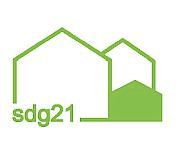 Since 2012, the DGNB certification system has been a tool for municipalities that helps them to optimise neighbourhoods in terms of sustainability and to document this through an award. For this system, the DGNB has now specifically further developed the criteria catalogue and significantly reduced the scope through adjustments. According to the DGNB in its press release, this would reduce the effort and costs for building owners "without compromising on quality". New in the updated system version are topics such as light pollution, smart infrastructure, governance, resilience and adaptability.
Since 2012, the DGNB certification system has been a tool for municipalities that helps them to optimise neighbourhoods in terms of sustainability and to document this through an award. For this system, the DGNB has now specifically further developed the criteria catalogue and significantly reduced the scope through adjustments. According to the DGNB in its press release, this would reduce the effort and costs for building owners "without compromising on quality". New in the updated system version are topics such as light pollution, smart infrastructure, governance, resilience and adaptability.
The revision of the criteria that has now taken place relates to the use profiles for urban districts and commercial districts. The restructuring and the significant reduction in scope from 46 to 30 criteria are the result of a targeted process in which a large number of experts from the DGNB network were involved.
The innovations in detail
In terms of content, numerous adjustments were made. For example, the criterion "social and functional mix" - a core issue of sustainable neighbourhood development - was given a stronger weighting. On the other hand, some topics that previously had only a minimal influence on the overall assessment were dropped. These include, for example, the criteria "art in construction" or "building site/construction process". Numerous other criteria were combined with related topics.
Four criteria were newly integrated or fundamentally revised. The criterion "Emissions / Immissions", which was previously called "Noise and Sound Protection", was expanded to include the topics of air quality and light pollution. The criterion "governance" aims to create structures in the planning stage that will endure after the realisation of the neighbourhood. The entirely new criterion of "resilience and adaptability" aims to promote neighbourhood development that implies the highest possible flexibility and resilience to possible disruptive events. The "Smart Infrastructure" criterion has been greatly expanded in its approach. This includes, among other things, the question of the extent to which digitalisation is fundamentally integrated into neighbourhood planning and what infrastructural prerequisites there are for this - in the buildings and the open spaces alike. This criterion, which takes into account the topic of "smart cities", was deliberately formulated in an open manner, as there is currently a great deal of technological movement in this area.
In order to ensure the international applicability of the DGNB system for neighbourhoods, the content of some criteria was expanded. This applies, for example, to the criterion "environmental risks", in which internationally relevant risks such as earthquakes, volcanic eruptions or tsunamis were added in addition to the environmental hazards that frequently occur in Germany, such as storms or floods.
Source: DGNB press release dated 13.9.2016
www.dgnb-system.de/...System_grundlegend_ueberarbeitet.pdf
Keywords:
Building materials / Construction, DE-News, DGNB, Quarters, Certification & Labels, Ecology



 Since 2012, the DGNB certification system has been a tool for municipalities that helps them to optimise neighbourhoods in terms of sustainability and to document this through an award. For this system, the DGNB has now specifically further developed the criteria catalogue and significantly reduced the scope through adjustments. According to the DGNB in its press release, this would reduce the effort and costs for building owners "without compromising on quality". New in the updated system version are topics such as light pollution, smart infrastructure, governance, resilience and adaptability.
Since 2012, the DGNB certification system has been a tool for municipalities that helps them to optimise neighbourhoods in terms of sustainability and to document this through an award. For this system, the DGNB has now specifically further developed the criteria catalogue and significantly reduced the scope through adjustments. According to the DGNB in its press release, this would reduce the effort and costs for building owners "without compromising on quality". New in the updated system version are topics such as light pollution, smart infrastructure, governance, resilience and adaptability.